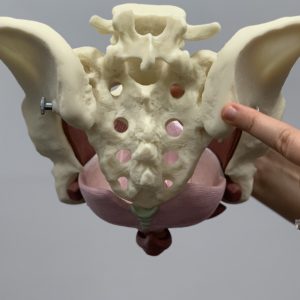 What does Pudendal Neuralgia even mean?
What does Pudendal Neuralgia even mean?
Pudendal = Refers to the Pudendal Nerve which originates in the sacral level of the spine (S2,3,4) then travels down branching off to supply the Clitoris, Bulbospongiosus and Ischiocavernosus (superficial pelvic floor muscles), the Perineum and the External Anal Sphincter.
Neuralgia = Refers to damage to the nerve itself by an injury or irritation or due to a specific nerve disorder.
Pudendal Neuralgia = Refers to damage to the Pudendal Nerve which will therefore affect the muscles it supplies.
There are many possible reasons for Pudendal Neuralgia such as post surgical trauma or post radiotherapy, but most commonly it occurs in cyclists who ride long distances regularly or entrapment of the nerve itself. Pudendal Nerve Entrapment can be caused by altered mechanics of the Sacroiliac Joint, dilation of blood vessels in the area, stretching of the nerve such as during childbirth or strained bowel movements or an altered pathway of the nerve in the individual. Pudendal Nerve Entrapment can occur a few places along its pathway and due to its three branches, depending on where the entrapment occurs, the signs and symptoms can vary.
Pudendal Neuralgia is usually positional in that it is usually caused by sitting, relieved by standing but usually ok with no direct pressure such as sitting on a toilet seat. Usually symptoms are fine at night whilst sleeping, minimal in the morning but gradually worsen through the day and may be experienced whilst getting to sleep. There is also a validated, specific criteria (The Nantes Criteria) that has been developed for the diagnosis of Pudendal Neuralgia from entrapment.
There are both conservative and surgical options for the treatment of Pudendal Neuralgia. Surgical options include both Pudendal Nerve Blocks and Decompression Surgeries. Conservatively, there is unfortunately minimal research to support Physiotherapy treatment techniques, however, knowledge of the condition and clinical practice helps guide us here. Treatments that have been trialed and have been successful in certain cases include correction of altered Sacroiliac Joint mechanics, surrounding muscle releases and education on the reduction of stretching of the nerve which includes bowel management strategies and pelvic floor muscle strengthening.
If you think you might have Pudendal Neuralgia or have any questions or concerns regarding this condition then come and see Bonnie, our Women’s Health Physiotherapist at Bend + Mend Physiotherapy in Sydney’s CBD.





